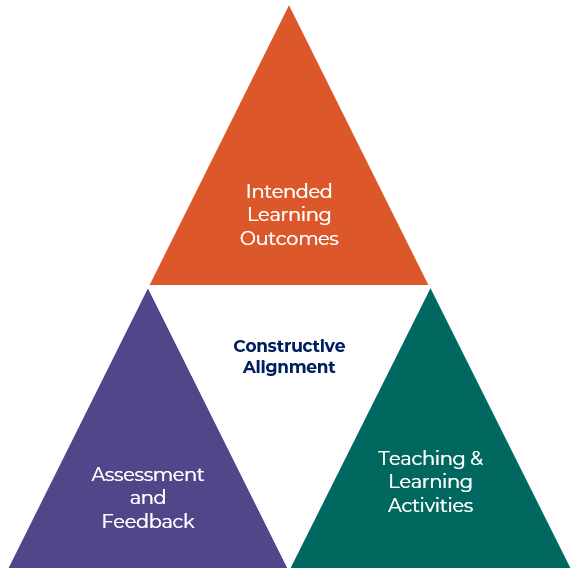Course aims and learning outcomes are important aspects of curriculum design. Often, they are assumed to be synonyms and will be used interchangeably. However, it is important to understand their individual purpose and how they are employed in the design of a course.
Why are they important?
Faculty and learners benefit from engaging with Aims and Outcomes. They support curriculum design by:
- Directing the design of a programme or course by addressing the needs of the learners;
- Providing the basis for coherence throughout a programme or course;
- Enabling learners to make informed choices about the programme or courses they wish to study; and
- Ensuring learners have a clear understanding about what they are expected to achieve throughout their studies.
Learning Aims
Learning Aims are typically applied at the programme and course level. They focus on the intended results of teaching, from the perspective of the teacher. Learning Aims set out the scope and the value, describing what the faculty intends to achieve through the delivery of the course.
They should answer the following questions:
- What is the purpose of the programme/course?
- What is the programme/course trying to achieve?
- What are the benefits for the learner?
As Learning Aims are broad statements of intent illustrating the overall purpose of the programme, they are not required to be measurable.
Learning Outcomes
Where Learning Aims are high-level statements of purpose and Learning Objectives act as operational descriptors of intent from the faculty perspective – Learning Outcomes specifically relate to the actions and achievements of the learners.
Outcomes can be applied at both the programme and course level. They describe both the skills and knowledge that learners will develop, and also describe how they will be demonstrated through summative assessment processes.
Learning outcomes describe the observable, measurable (assessable) demonstrations of knowledge and skills. They are derived from the Learning Aims set at the higher level and are intrinsically linked to the designed learning activities and assessment methods.
| How do Learning Outcomes differ at the Programme and Course level? | |
| Programme Learning Outcomes | Statements of what successful learners will achieve upon completion of their degree. They are aspirational and capture the broader outcomes of learning. They are distinct Learning Outcomes in their own right and not an aggregation of the Learning Outcomes applied at the course level. |
| Course Learning Outcomes | Course Learning Outcomes align and contribute to programme level outcomes. They describe the mechanisms in which the outcomes will be measured and through which learning activities they will be achieved. |
Well-written Learning Outcomes have three basic elements:
- An action verb that describes the learner behaviour which will demonstrate learning;
- Contextual information in which the activity will happen; and
- The level to which (how well) the outcome will be demonstrated.
‘How well’ an outcome should be demonstrated is the most difficult aspect of writing Learning Outcomes. Often, this is supported with the provision of a detailed assessment criteria (known as a rubric) which helps to articulate the broader range of marks attainable against a given Learning Outcome based on the performance of the learner.
Designing Learning Outcomes
If you're designing Learning Outcomes, either for the first time or as part of a redesign of your course curriculum, it is important to ensure you create an explicit relationship between the purpose of the course, the teaching and learning activities and the assessment mechanisms. Bloom's Taxonomy and Constructive Alignment can support this design.
You may also wish to consult the QAA (Quality Assurance Agency) Guidance on creating appropriate and relevant Learning Outcomes.
Bloom’s taxonomy (1956) is often used as a guide for writing Learning Outcomes. The taxonomy was originally intended to classify ‘thinking behaviours’ that were believed to underpin learning processes:
- The Cognitive Domain – knowledge
- The Affective Domain – attitudinal
- The Psychomotor Domain – skills
You will likely be familiar with the Cognitive Domain, in its revised format following the work by Anderson and Krathwohl (2001):
| Remembering | Know; Define; Memorise; List; Recall; Name; Relate; Identify; State; Describe; Show; Quote; Present |
| Understanding | Discuss; Review; Explain; Locate; Illustrate; Clarify; Select; Summarise; Conclude |
| Applying | Solve; Examine; Modify; Interpret; Apply; Use; Practise; Demonstrate; Classify |
| Analysing | Differentiate; Investigate; Appraise; Criticise: Debate: Compare; Contrast; Distinguish; Analyse |
| Evaluating | Judge; Select; Evaluate; Choose; Assess; Rate; Measure; Argue; Defend |
| Creating | Assemble; Build; Compile; Construct; Create; Design; Develop; Formulate; Invent; Plan; Propose; Synthesise |
The six levels of the Cognitive Domain support the identification of the appropriate level of learning we want to design across our courses. This, in conjunction with example action verbs provided, act as a helpful guide for writing Learning Outcomes.
In recent years, the use of Bloom’s Taxonomy has come under increasing scrutiny due to the lack of empirical validation and its oversimplification of the learning process. The taxonomy itself is not explicitly learner-centric and does not answer any question regarding learner autonomy, prior knowledge or social relatedness (Deci & Ryan, 2012) . Despite this, the Taxonomy is still a useful tool to build relevant, measurable and observable Learning Outcomes.
Learning Outcomes should be developed as part of a deliberate and purposeful approach to Curriculum Design. The practice of Curriculum Design is underpinned by three core design processes, these are:
- Designing relevant and appropriate Learning Outcomes for the subject and level of study;
- Designing learning and teaching activities that provide learners with the knowledge and skills to meet the Learning Outcomes; and
- Designing assessment methods that enable learners to demonstrate their ability to meet the Learning Outcomes.
The integration of these three processes provide the basis for a much more effective learning experience. This practice is known as Constructive Alignment (Biggs, 1999).

Constructive Alignment is an accessible representation of commonly agreed upon aspects of curriculum design and educational theory. It serves as a guideline for good educational design. A well aligned piece of teaching is more likely to result in a positive learning experience as it delivers a clearer understanding of the purpose of the course, how it will be taught and how it will be assessed. In addition, it helps faculty design and deliver a much more consistent curriculum.
The School delivers postgraduate programmes at level 7 (UK classification for qualifications). The QAA has developed the Frameworks for Higher Education Qualifications of UK Degree-Awarding Bodies. The frameworks provide a full descriptor for masters level study and a holistic view of the level in which learners operate at, as below:
Typically, holders of the qualification will be able to:
- deal with complex issues both systematically and creatively, make sound judgements in the absence of complete data, and communicate their conclusions clearly to specialist and non-specialist audiences
- demonstrate self-direction and originality in tackling and solving problems, and act autonomously in planning and implementing tasks at a professional or equivalent level
- continue to advance their knowledge and understanding, and to develop new skills to a high level.
And holders will have:
- the qualities and transferable skills necessary for employment requiring: - the exercise of initiative and personal responsibility
- decision-making in complex and unpredictable situations
- the independent learning ability required for continuing professional development.
Learning Aims
‘The aim of this course is to provide learners with the necessary understanding of how technology and digital platforms have disrupted industries and traditional business models. This course will examine business adaptation, competitiveness and the key aspects of transforming business through digital means so that you are able to evaluate the effectiveness of different digital transformation strategies and present recommendations for successful change.’
As you can see, the aim sets out a purpose for the course and the expectations for what it intends to achieve. In addition, it makes clear what the benefit is to the learner. They are suited to being included in course handbooks and clearly displayed in the course outline.
Learning Outcomes
‘By the end of this course you will: Develop a critical discussion on the role of technology in supporting businesses to adapt to intensified globalisation and consumer connectivity considering multiple perspectives and evidence, suitable for presentation at board level.’
If we break the example down into its component parts, we can see the following:
- What the learner will do: Develop a critical discussion on the role technology plays in supporting businesses to adapt to intensified globalisation and consumer connectivity
- In what context: that considers multiple perspectives and evidence
- ‘How well’ will they do it: suitable for presentation at board level
Learning Outcomes can be applied at different levels of the course. You are likely to have overarching Outcomes applied at the course level, and individual outcomes that are assessed through each course stage (e.g. topic/week).
Related materials
When designing Learning Outcomes, it is important to be aware of the relevant frameworks in order to align outcomes to the appropriate level:
If you would like support or assistance with Curriculum Design or any other aspects of your teaching and learning practice, please contact Learning Innovation.
References
Anderson , L. & Krathwohl , D., 2001. A taxonomy for teaching, learning and assessing: A revision of Bloom's taxonomy of educational objectives. New York: Longman.
Biggs, J., 1999. Teaching for Quality Learning at University. Buckingham: Open University Press.
Bloom, B., 1956. Taxonomy of Educational Objectives, Handbook I: The Cognitive Domain. New York: David McKay Co Inc..
Deci, E. & Ryan, R., 2012. Motivation, Personality, and Development Within Embedded Social Contexts: An Overview of Self-Determination Theory. The Oxford Handbook of Human Motivation, pp. 85-107.
